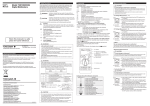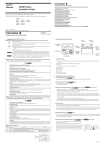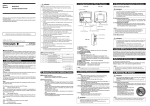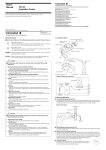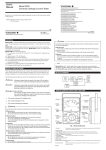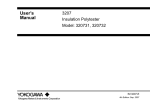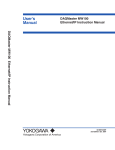Download Store this manual in a safe place for future reference.
Transcript
Safety Precautions User’s Manual Measuring Instructions Various symbols are used on the instrument and thoughout this manual to ensure safe use of the product and to protect against possible hazards or damage. The following safety symbols are used where app. opriate. Read the explanations carefully and familiarize yourself with the symbols before reading the text. Model 73201/02/03/04 Digital Multimeters This symbol indicates that misuse of the instrument could result in in- WARNING jury or death of personnel. This symbol indicates that misuse of the instrument could result in in- CAUTION jury of personnel or damage to the instrument. The instrument and this manual also use the following safety symbols: Caution This symbol indicates that the operator must refer to an explanation in the instruction manual in order to avoid the risk of injury or death of personnel or damage to the instrument. Double Insulation This symbol indicates double insulation. Alternating current This symbol indicates AC voltage/current. Direct current This symbol indicates DC voltage/current. Fuse This symbol indicates a fuse. Earth TERMINAL This symbol indicates ground. Store this manual in a safe place for future reference. WARNING IM 73201E 5th Edition Feb. 2006 (KP) ■ To avoid electric shock! • Do not use deteriorated or damaged testing leads. Check testing leads before use. • Do not use the instrument if there is any damage to the casing or when the casing is removed. • Disconnect the instrument from the circuit under test before opening the casing to replace the batteries or for any other reason. • Avoid using the instrument if it has been exposed to rain or moisture or if your hands are wet. ■ To avoid electrical shock or fire! Do not use the instrument in an atmosphere where any flammable or explosive gas is present. CAUTION • Do not use the multimeter near noise-emitting equipment or where there may be a sudden temperature change. Otherwise, the instrument may produce an unstable reading or errors. • Do not wipe the instrument using any organic solvent such as benzine or paint thinner. Otherwise, the front panel may be damaged or discolored. When cleaning the instrument, use a dry cloth. • Do not leave the multimeter exposed to direct sunlight or in a hot and humid location such as the inside of a car, for any prolonged length of time. Components • AC Voltage Measurement ( V) 1) Function Switch Turns off the power or selects the measurement mode. OFF: Turns off the power. V: AC voltage measurement V: DC voltage measurement : Resistance measurement and continuity check (73202/03) Ω/ Ω: Resistance measurement (73201/04) : Continuity check (73201/04) : Diode test : Capacitor check (73202/03) µA: DC/AC current measurement in micro-amperes mA: DC/AC current measurement in milli-amperes (73201/02/03) A: DC/AC current measurement in amperes 2) SELECT key (73202/03) or / key (73201)* This function is not supported on the 73204 multimeter. This key is enabled only if the multimeter is in one of the following measurement modes. In this mode, the button selects between the resistance measurement and continu• Ω/ : ity test. : In this mode, the button adjusts the stray capacitance of the testing leads and the • multimeter itself to zero. CAL symbol.) (The display shows the • µA/mA/A: In this mode, the button selects between the DC and AC modes. * The 73201 multimeter comes with the / key instead of the SELECT key. This key is used only to select between the DC and AC modes in the current measurement mode. 3) RANGE key * This function is not supported on the 73204 multimeter. Allows the operator to select the measuring range manually (the display shows the R • H symbol). To return to the normal auto-ranging mode, hold down this button for at least one second until the display shows “AUTO.” 4) AUTO-H key Set up AUTO HOLD function. (the display shows the A • H symbol). V WARNING Measurement Category (CAT.) SELECT 400/4000 uA 40/400 mA 4/10 A OFF µA mA A COM V Black testing lead Red testing lead RANGE AUTO.H V / / 400/4000 V uA 40/400 V mA 4/10 OFF A µA mA A COM V Black testing lead Red testing lead *(2) and (3) are not supported on the 73204 multimeter. / / a) Set the function switch from the OFF position to the V position. b) Plug the black testing lead into the COM input terminal and the red input terminal. testing lead into the V•Ω• c) Connect the testing leads to the circuit under test and then read the multimeter when it stabilizes. d) When measurement is complete, set the function switch back to the OFF position and turn off the multimeter. NOTE Do not mistake the following for a malfunction! If the 400 mV range is selected and the testing leads are left open-circuited, the multimeter may give a certain reading. This does not affect your measurement. • Resistance Measurement (Ω) CAUTION To avoid damage to instrument! Turn off the power to the circuit under test before starting measurement in order to prevent any excessive voltage from being applied to the multimeter. / / 400/4000 V uA 40/400 V mA 4/10 OFF A <4> AUTO.H key µA mA A COM V 400/4000 V a) Set the function switch from the OFF position to the V position. b) Plug the black testing lead into the COM input terminal and the red input terminal. testing lead into the V•Ω• c) Connect the testing leads to the circuit under test and then read the multimeter when it stabilizes. d) When measurement is complete, set the function switch back to the OFF position and turn off the multimeter. • DC Voltage Measurement ( V) <2> SELECT key (73202/03) or ( /= key (73201) <3> RANGE key ■ To avoid damage to instrument or electric shock! The restrictions on the maximum voltage level for which the 73201, 02, 03 and 04 multimeters can be used, depend on the measurement categories specified by the safety standards. These category specifications are formulated to protect operators against transient impulse voltages in power lines. / / V V <5> Display DIGITAL MULTIMETER Yokogawa Meters & Instruments Corporation International Sales Dept. Tachihi Bld. No.2, 6-1-3, Sakaecho, Tachikawa-shi,Tokyo 190-8586 Japan Phone: 81-42-534-1413, Facsimile: 81-42-534-1426 YOKOGAWA CORPORATION OF AMERICA (U.S.A.) Phone: 1-770-253-7000 Facsimile: 1-770-251-2088 YOKOGAWA EUROPE B. V. (THE NETHERLANDS) Phone: 31-334-64-1611 Facsimile: 31-334-64-1610 YOKOGAWA ENGINEERING ASIA PTE. LTD. (SINGAPORE) Phone: 65-6241-9933 Facsimile: 65-6241-2606 YOKOGAWA AMERICA DO SUL S. A. (BRAZIL) Phone: 55-11-5681-2400 Facsimile: 55-11-5681-1274 YOKOGAWA MEASURING INSTRUMENTS KOREA CORPORATION (KOREA) Phone: 82-2-551-0660 to -0664 Facsimile: 82-2-551-0665 YOKOGAWA AUSTRALIA PTY. LTD. (AUSTRALIA) Phone: 61-2-9805-0699 Facsimile: 61-2-9888-1844 YOKOGAWA INDIA LTD. (INDIA) Phone: 91-80-4158-6000 Facsimile: 91-80-2852-1441 YOKOGAWA SHANGHAI TRADING CO., LTD. (CHINA) Phone: 86-21-6880-8107 Facsimile: 86-21-6880-4987 YOKOGAWA MIDDLE EAST E. C. (BAHRAIN) Phone: 973-358100 Facsimile: 973-336100 LTD. YOKOGAWA ELECTRIC (RUSSIAN FEDERATION) Phone: 7-095-737-7868 Facsimile: 7-095-737-7869 CAUTION To avoid damage to Instrument or equipment. • Before starting measurement, check to which mode the function switch is set and make sure the testing leads are plugged into the terminals for the desired mode of measurement. • Temporarily remove the testing leads from the device under test before operating the function switch. uA 40/400 V mA 4/10 <1> Function switch Black testing lead Red testing lead Input terminal • Continuity Check ( A OFF a) Place the function switch in the Ω position (73201/04) or Ω/ position (73202/03). b) Plug the black testing lead into the COM input terminal and the red input terminal. testing lead into the V•Ω• c) Connect the testing leads to the circuit under test and then read the multimeter when it stabilizes. d) When measurement is complete, place the function switch in the OFF position and turn off the multimeter. Maximum Input Voltage II 600 V III 300 V A µA mA COM V ) CAUTION IM3E-2006.2 Measurement category Description Remarks 1 CAT.1 For measurements performed on circuits not directly connected to MAINS. 2 CAT.2 For measurements performed on circuits Appliances, portable equipments, etc. directly connected to the low voltage installation. 3 CAT.3 For measurements performed in the building installation. Distribution board, circuit breaker, etc. 4 CAT.4 For measurements performed at the source of the low-voltage installation. Overhead wire, cable systems, etc. 5) Display View with All Elements Turned On Symbol and Unit A•H Distribution Board Entrance Cble CAT. CAT.3 CAT.2 T CAT. Outlet etc. Equipment R•H AUTO AUTO POWER OFF nF, µF mV, V µA, mA, A Ω, kΩ, ΜΩ CAL +– To avoid damage to instrument! Turn off the power to the circuit under test before starting measurement in order to prevent any excessive voltage from being applied to the multimeter. Description Lit when in DC-mode measurement Lit when in AC-mode measurement Polarity indicator lit when the polarity is negative Lit when in diode test Lit when in continuity check AUTO HOLD indicator Manual range indicator Auto range indicator AUTO POWER OFF indicator Unit for capacitance measurement Unit for voltage measurement Unit for current measurement Unit for resistance measurement Lit when stray capacitance is adjusted to zero Lit when the batteries are low a) If the model is 73201 or 04, place the function switch in the / / 400/4000 V uA 40/400 V mA 4/10 A OFF A µA mA COM V Black testing lead Red testing lead position. If the model is 73202 or 03, place the function switch in the Ω/ position, and then press the SELECT key. (The on the display.) symbol appears b) Plug the black testing lead into the COM input terminal and the red input terminal. testing lead into the V•Ω• c) Connect the testing leads to the circuit under check. If the circuit is continuous (no more than approximately 50 Ω), the buzzer sounds. d) When the test is complete, place the function switch in the OFF position and turn off the multimeter. • Diode Test ( ) AUTO HOLD Function position. a) Set the function switch from the OFF position to the b) Plug the black testing lead into the COM input terminal and the red input terminal. testing lead into the V•Ω• c) Connect the testing leads to the diode and then read the multimeter when it stabilizes. (1) Forward-bias Diode Test Black testing lead Connect the black testing lead to the cathode and the red testing Red testing lead lead to the anode (see Figure 1). Silicon diodes should give a reading of approximately 0.5 V and light-emitting diodes a reading between 1.5 V and 2.0 V. Note that readings close to 0 V represent a short-circuit and the "---" symbol indicates an open-circuit. (2) Reverse-bias Diode Test Black testing Red testing Connect the black testing lead to the anode and the red testing lead lead lead to the cathode (see Figure 2). Normally, the display shows the "---" symbol, indicating that the diode under test is normal. The diode is defective if the display gives a certain voltage level. d) When the test is complete, set the function switch back to the OFF position and turn off the multimeter. / / 400/4000 V uA 40/400 V mA 4/10 A OFF A µA mA COM V Figure 1 Forward-bias Diode Test Red testing lead Specifications The 732 series of multimeters can automatically retain the measured value when the testing leads are handled as described below. a) Press the AUTO.H key. (The display shows the A • H symbol.) b) Connect the testing leads to the object under test. c) When the reading stabilizes, the buzzer sounds. d) Remove the testing leads from the object under test. e) The multimeter now shows the measured value that it retains. f) You can repeat steps b) to e) as many times as you like as long as the display shows the A • H symbol. NOTE Do not mistake the following for a malfunction! • In DC voltage measurement, the AUTO HOLD function is only available for ranges greater than the 4 V range. • This function is not available for current-mode measurement. • In a capacitor check, the AUTO HOLD function requires a few seconds before it takes effect. • The AUTO HOLD function cannot be applied to unstable signals. g) To cancel this function, press the A•H key once again. AUTO POWER OFF Function Black testing lead Figure 2 Reverse-bias Diode Test • Capacitor Check ( ) *This function is not supported on the 73201/04 multimeters. The multimeter automatically turns off if no key is pressed for a period of 20 minutes. The multimeter will beep for approximately one minute to alert the operator before the automatic power-off function takes effect. (Pressing any key while the multimeter is beeping postpones the power-off time. Pressing any key once after the power to the multimeter is automatically turned off switches the multimeter on again.) To cancel the automatic power-off function, hold down the SELECT key and then set the function switch from the OFF to the position of any desired measurement mode. (The AUTO POWER OFF indication turns off when the function is canceled.) To enable the function once again, temporarily switch the function switch back to the OFF position, and then select the desired measurement mode. CAUTION To avoid damage to Instrument or equipment. Before starting measurement, be sure to discharge the capacitor under check. position. a) Set the function switch from the OFF position to the b) Plug the black testing lead into the COM input terminal and the red testing lead into the µA•mA• input terminal. c) Press the SELECT key to adjust the stray capacitance to zero (the display shows the CAL symbol). d) Connect the testing leads to the circuit under check and then read the multimeter when it stabilizes. e) When measurement is complete, set the function switch back to the OFF position and turn off the multimeter. / / 400/4000 V uA 40/400 V mA 4/10 OFF A A µA mA COM V Red testing lead Black testing lead Do not mistake the following for a malfunction! Zero calibration is only effective when the 20nF range is selected. • Current Measurement (µA/mA/A) *This fucntion is not supported on the 73204 multimeter. CAUTION To avoid damage to instrument! • Check to which mode the function dial is set before starting measurement. • A current of 11 to 20 A can also be measured if the time interval is kept within 30 seconds. The buzzer will sound if the interval exceeds 30 seconds. If this happens, immediately stop measurement. To continue measurement, wait for 2 minutes or more when restart. a) Set the function switch from the OFF position to either the µA, mA or A position. (If the magnitude of the current being measured is not known, select the A position.) b) When measuring AC current, press the SELECT key to select the AC mode. (The display shows the “ ” symbol to indicate AC-mode measurement.) c) Plug the black testing lead into the COM input terminal and the red testing lead into the A input terminal. If the current is in the order of milli-amperes or less, plug the red testing lead into the µA•mA• input terminal. d) Connect the testing leads to the circuit under test and then read the multimeter when it stabilizes. e) When measurement is complete, set the function switch back to the OFF position and turn off the multimeter. mA / / A 400/4000 V uA uA 40/400 40/400 V mA mA 4/10 A A µA mA COM V Red testing lead Black testing lead A / / 400/4000 V V OFF 4/10 OFF A A µA mA COM V Red testing lead Black testing lead If the batteries fall below the normal operating voltage, the symbol turns on. If this happens, replace the batteries with new ones (AAA-size [ANSI] batteries....2). CAUTION To avoid electric shock! • Be sure to disconnect the multimeter from the circuit under test before replacing the batteries. • Replace both batteries at the same time making sure to position them with the correct polarities. b) c) a) CAUTION mA 400 µA*1 4000 µA 0.1 µA 1 µA 40 mA*2 400 mA 0.01 mA 0.1 mA A 10 A*3 F02:15 A/250 V protection fuse F05:500 mA/250 V protection fuse View with the Casing Open 73202 73203 1% + 2 Voltage Drop Maximum Input Current <0.17 mV/µA 400 mA The input is protected by a 500 mA/250 V fuse 10 A The input is protected by a 15 A/250 V fuse <3 mV/mA <0.04 V/A 0.01 A 2% + 2 *1, *2 These ranges may produce a readout error equivalent to several times their resolution. *3 A current of 11 to 20 A can also be measured if the time interval is kept within 30 seconds. The buzzer will sound if the interval exceeds 30 seconds. Response: 1 sec maximum • AC Current Measurement ( A) * This function is not supported on the 73204 multimeter. (Mean-value detection and rms-value calibration) Range Resolution Accuracy (40-500 Hz) 73201 µA 400 µA*1 4000 µA 0.1 µA 1 µA mA 40 mA*2 400 mA 0.01 mA 0.1 mA A 10 A*3 73202 73203 2% + 20 2% + 5 2% + 20 Maximum Input Current <0.17 mV/µA 400 mA The input is protected by a 500 mA/250 V fuse 10 A The input is protected by a 15 A/250 V fuse <3 mV/mA 2% + 5 2.5% + 20 0.01 A Voltage Drop <0.04 V/A *1, *2 These ranges may produce a readout error equivalent to several times their resolution. *3 A current of 11 to 20 A can also be measured if the time interval is kept within 30 seconds. The buzzer will sound if the interval exceeds 30 seconds. Response: 2 sec maximum • Resistance Measurement (Ω) Range 400 4K 40K 400K 4M 40M Resolution Ω Ω Ω Ω Ω Ω 0.1 0.001 0.01 0.1 0.001 0.01 Accuracy 73201/02/03/04 0.75%+2 Ω kΩ kΩ kΩ MΩ MΩ 0.75%+1 Measuring Open-loop Input Protective Current Voltage Voltage <1.0 mA <3.4 V 600 V <0.5 mA <1.0 V <70 µA <0.7 V <7 µA <0.7 µA <70 nA • DC Voltage Measurement ( V) • Continuity check ( 400 4 40 400 600 mV V V V V 0.1 0.001 0.01 0.1 1 mV V V V V 73201 0.5%+1 73202/04 0.5%+1 2%+1 5%+2 ) Maximum Input Voltage Range Resolution 73203 Input Resistance Range of operation 73201/02/03/04 Open-circuit Voltage Input Protective Voltage 600 V 400 Ω 0.1 Ω The buzzer turns on for resistances lower than 50 ±20 Ω. <3.4 V 600 V 0.3%+1 >100MΩ 11MΩ 10MΩ Open-circuit Voltage Input Protective Voltage <3.4 V 600 V Accuracy Resolution Response: 0.2 sec maximum (for a buzzer response) 0.75%+1 • Diode Test ( Response: 1.5 sec maximum for 400 mV range or 1 sec maximum for other ranges Range Resolution Accuracy (40-500 Hz) 73201 4V 40 V 400 V 600 V 0.001 V 0.01 V 0.1 V 1V Response: 2 sec maximum To avoid electric shock! • Be sure to disconnect the multimeter from the circuit under test before replacing the fuse(s). • Do not operate the multimeter with the casing left open. • In order to avoid damage to the multimeter or any possible accident, use fuses of the specified rating. To replace the fuse(s): a) Remove the three screws on the back of the casing. b) Open the casing. c) Remove the blown fuse from the fuse holder. d) Install a new fuse in the holder. e) Close the casing and fasten it with the three screws. µA ) Range Resolution 2V 0.01 V Accuracy 73201/02/03/04 1% + 1 (for measuring currents smaller than 1.0 mA) (Mean-value detection and rms-value calibration) If a current greater than the rated value flows when the multimeter is in the current-measurement range, a protection fuse may blow. If this happens, replace that fuse. The multimeter contains the following two types of fuses: • Type F05 250 V/500 mA fuse • Type F02 250 V/15 A fuse Accuracy 73201 Response: 1 sec maximum for ranges lower than the 400 kΩ range, 5 sec maximum for the 4 MΩ range, and 15 sec maximum for the 40 MΩ range • AC Voltage Measurement ( V) Fuse Replacement Resolution Range 2. Electrical Specification Test conditions: 23 ±5°C at 80% RH maximum Accuracy: ±(percentage of reading + number of LSD reading) Note: Each response noted below is a value measured in the Range Hold mode (manual range setting). Range To replace the batteries: a) Remove the three screws on the back of the casing. b) Open the casing. c) Take the battery holder out of the casing. d) Replace the batteries with new ones and install the battery holder back into the casing. e) Close the casing and fasten it with the three screws. NOTE mA Battery Replacement 1. General Specifications • Measurement functions: AC voltage, DC voltage, AC current (73201/02/03), DC current(73201/ 02/03), resistance, continuity, diode and capacitance (73202/03) • Additional functions: Auto hold, manual range selection, over-range alarm, and Auto power off. • Display: LCD display that is capable of indicating a significant reading of up to 4300 counts along with the indications of the unit and function. It shows the negative polarity only; no indication is given for positive lowpolarity. The display also has the OL or over-range and battery alarm indicators. Note: The most significant reading is 210 counts for the diode test and 2300 counts for the capacitor check. • Range selection: Manual or automatic • Sampling: 2 times/sec • Operating temperature and humidity ranges: 0 to 50°C (Accuracy guaranteed range: 23±5°C) Where the range is 0 to 40°C for humidity of 80%RH or less and 40 to 50°C for humidity of 70%RH or less • Storage temperature and humidity ranges: -20°C to 60°C; 70% RH maximum • Battery life: Approximately 600 hours (when continuously operated on alkaline batteries) • Power supply: AAA-size batteries (ANSI) .......................................................... 2 • External dimensions: 74 (W) × 155 (H) × 31 (D) mm (excluding protrusions) • Weight: Approx. 240 g (including batteries) • Safety standards: EN61010-1, EN61010-2-031 (AC/DC 300V CAT.III, AC/DC 600 V CAT. II, Pollution degree2) • EMC standards: EN55011 Group 1 Class B EN61326-1 • Effect of EMS immunity: Accuracy range of reading: [Rated accuracy + 5.0% of each range] for the strength of a radio-frequency electromagnetic field of 3 V/m • Operable altitude: 2000m or less above sea level. • Accessories: Batteries (housed in the instrument) ............................................. 2 Testing leads ............................................................................ 1set Spare fuse: F05 (500 mA/250 V) ................................................. 1 F02 (15 A/250 V) ...................................................... 1 Instruction manual ........................................................................ 1 • DC Current Measurement ( A) * This function is not supported on the 73204 multimeter. 73202 1%+5 73203/04 0.75%+5 Input Resistance Maximum Input Voltage 11 MΩ, <50 pF 10 MΩ, <50 pF 600 V Response: 1 sec maximum • Capacitor check ( Range ) Resolution 73201/04 20 nF 200 nF 2 µF 20 µF 200 µF 0.01 nF 0.1 nF 0.001 µF 0.01 µF 0.1 µF This function is not available. Response: 1 sec maximum Accuracy 73202 Protection Fuse 73203 2% + 5 typical By means of Readings in the 20nF range are a 500 mA/250 V fuse values after zero calibration has been completed.


